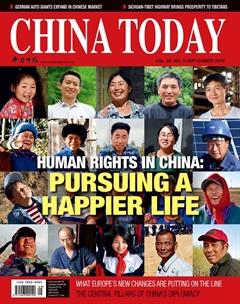Foreign Trade Grows Steadily with Increase of Internal Drivers of Growth

Foreign Trade Grows Steadily with Increase of Internal Drivers of Growth
Statistics from the General Administration of Customs show that Chinas imports and exports of goods totaled RMB 17.41 trillion in the first seven months of this year, up 4.2 percent year-onyear. Among them, the growth rate of imports and exports from private enterprises reached an eye-catching 11.8 percent, becoming an important driving force for Chinas foreign trade.
In the first seven months, Chinas imports and exports to the Belt and Road partner countries totaled RMB 5.03 trillion, accounting for 28.9 percent of its total foreign trade value. At the same time, Chinas imports and exports to the EU, ASEAN, Japan, and other major markets have also maintained a steady growth.
The imports and exports from Chinas private enterprises are growing rapidly. In the first seven months, private enterprisesimports and exports reached RMB 7.31 trillion, accounting for 42 percent of Chinas total foreign trade.
Regarding the overall trend of foreign trade in the second half of the year, it is believed that Chinas door will open wider. This year, China will further facilitate trade, continue to improve the business environment at ports, make it easier for foreign trade enterprises to do business, and promote the steady development of its foreign trade.
129 Chinese Companies Listed in the World Top 500
Fortune magazines 2019 Fortune 500 list was released on July 22. Chinese companies accounted for 129 of the 500 companies by revenue, surpassing U.S. companies for the first time. Chinese companies accounted for three of the top five, with Sinopec, PetroChina, and the State Grid Corporation of China ranking second, fourth, and fifth respectively.
In addition to the increase in the number of Chinese companies on the list, the size and revenue of Chinese companies have also continued to expand, with 77 of them having moved up the list. Of the 25 new and re-listed companies in this years top 500, 13 are from China, accounting for half of the total. Xiaomi, nine years old, is the youngest company in the 2019 Fortune 500.
The Fortune 500 is a list which reflects the size and strength of large companies. The 2019 ranking reflects the increase in the overall size and strength of Chinese companies.
However, in many industries, the international competitiveness of Chinese enterprises still needs to be improved, especially in the areas of research and development, design, and branding.
Profitability is an important aspect as enterprises have to compete with others in the market. Large sales are not equal to strong profitability.
Per Capita Disposable Income Increased 59.2 Times in the 70 Years
According to a recent report by the National Bureau of Statistics, over the past 70 years since the founding of the Peoples Republic of China, the income of urban and rural residents has maintained rapid growth, and the level of consumption has increased remarkably. China has achieved a lot thanks to its efforts in poverty reduction.
According to the report, the per capita disposable income of Chinese residents was RMB 49.7 in 1949, and reached RMB 28,228 in 2018, a nominal increase of 566.6 times, a real increase of 59.2 times, and an average annual real growth of 6.1 percent. In 1956, the per capita expenditure was only RMB 88.2. In 2018, it reached RMB 19,853, with a nominal increase of 224.1 times and a real increase of 28.5 times, representing an average annual real growth of 5.6 percent.
By the end of 2018, the number of rural poor in China had dropped to 16.6 million, or about 750 million less than that at the end of 1978, according to the poverty line for rural residents set in 2010.

TCM Becomes a Hotspot of BRI Economic and Trade Cooperation
Since the Belt and Road Initiative(BRI) was put forward, international cooperation and exchange programs about traditional Chinese medicine(TCM) have been steadily promoted in the BRI partner countries. At present, TCM has spread to 183 countries and regions, becoming an important part of the health and economic cooperation between China and ASEAN, EU, Africa, Central and Eastern Europe, and other regions.
“TCM is a key industry for overseas exchanges and cooperation under the framework of BRI, and has become an important part of Chinas soft power. The development of the TCM industry is having an increasingly significant impact on employment and peoples livelihood,” said Professor Zhu Chang of Fudan University.
In order to accelerate the development of TCM in BRI partner countries, there are three steps that should be taken. First, as TCM is a key part of Chinese culture, it should be incorporated into the teaching of Chinese culture. Second, China needs to cultivate talents who can both speak foreign languages and know about TCM. Third, China should recruit more TCM practitioners into its medical aid teams in foreign countries.
Qin Qian, associate professor at Fudan University, believes that the development of TCM should make better use of the opportunities brought by the BRI, and take measures according to local conditions.

